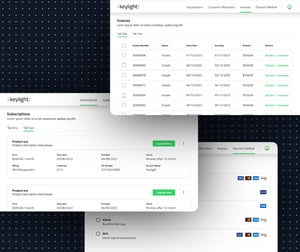The Anatomy of Subscription Businesses | Part one
 rom e-commerce to healthcare, the world of subscription-based businesses have flourished in the last two years, and it’s only just beginning. It’s not just new businesses that are emerging in the market, but established organizations that you wouldn’t typically associate with a subscription-based model, who have harnessed an opportunity to grow, enhance, and future-proof their organizations by thinking differently.
rom e-commerce to healthcare, the world of subscription-based businesses have flourished in the last two years, and it’s only just beginning. It’s not just new businesses that are emerging in the market, but established organizations that you wouldn’t typically associate with a subscription-based model, who have harnessed an opportunity to grow, enhance, and future-proof their organizations by thinking differently.
In this new series, we’re going to look at the anatomy of subscription businesses:
- Exploring how physical products and services can embrace subscription models
- Looking at their chemical makeup
- Establishing why all subscription platforms are not created equal
In this first article, we explain why so many businesses are embracing the subscription model and why any business type can do it.
The rise of subscription-based models
The growth in subscription-based businesses has skyrocketed in the last decade, growing nearly six times faster than the S&P 500 up to 2021 according to research. Recent numbers show revenue growth of more than 400% since 2012, and in Q4 2020 alone subscription companies reported a growth rate of 20%.
Subscription-based businesses showed high levels of resilience during the pandemic, vastly superior consumer connections, and they have a direct synergy with the modern way of living and working. The benefits that became apparent in lockdown, however, are not isolated to pandemics, the global situation merely highlighted their relevance both to companies and consumers in the modern world.
The reasons for that growth are a combination of opportunity, capability, and demand. As mentioned, the subscription approach works well with modern life and tends to be more affordable for consumers. As customers have become more familiar with the premise across a variety of sectors, there is also greater demand and expectation for similarly easy customer experiences.
In addition, advances in the tech infrastructure have facilitated the development of subscription models and improved their capabilities and execution. For example, analytics platforms have made it possible for businesses to gain insights into consumer behavior and digital payment platforms allow for easy payment processing. From a business perspective, the sustainability of a subscription business has been an incentive to embrace the development of associated models and technologies.
Rewarding investment for the customers
- Cost
Subscription services tend to be more cost-effective. E.g. subscribing to a fitness app instead of having a personal trainer. - Convenience
Customers can pay for and use services according to their needs, and scale as that need changes. - Customization
They can personalize their use, payment plans, and specific requirements.
Viable investment for businesses
- Reliable income
Businesses benefit from repeat and predictable revenue when customer relationships and experiences are managed well. - Sustainable business
If reliable revenue is achieved, it will make for a more sustainable business model that benefits from cumulative growth and income rather than relying solely on the costly nature of constantly winning new customers or individual sales. - Customer insights
When you have the right technology, subscription models allow you to gain key customer insights which will help you improve your product or service for the future, improve that customer experience and create further resilience and strength within your business.
A multi-industrial phenomena
The most commonly cited reason for any business to explore subscription models is the prospect of reliable, consistent, and predictable revenue. While that’s certainly a factor, it is not the most important, exciting, or beneficial feature of subscription models. To start with repeat revenue as your main motivating factor tends to lead to poor and even destructive decisions in the set-up and management of the organization. It’s something we discussed in our previous article - Customer experience: Personalization throughout the sales cycle.
The as-a-service model gives businesses more room to be agile with their offering and provides more touchpoints to understand customers.
That, in turn, has the potential to provide repeat revenue, but it also allows you to establish much more valuable customer relationships that will help to future-proof your company in a world of constant innovation, evolution, and game-changers.
Traditionally, you might have had a subscription to a magazine, a newspaper, or the gym. In recent years, that has evolved to digital services like Netflix, Spotify, and perhaps Adobe Creative Cloud. However, as a result of the benefits of subscription models and the changing market, we are seeing more sectors entering the marketplace. Those that are traditionally associated with physical products or services are adapting or extending their offering, pivoting to a subscription-first approach where the primary ‘product’ is actually a service.
For example, we have famously seen the rise of Amazon Prime, which leverages its knowledge of logistics to ship products cost-effectively, reliably, and at scale. Other industries entering the space include:
- Travel
Surf Air offers customers unlimited flights on its private planes for a set monthly subscription fee. - Fitness
There has been an explosion of at-home workout programs, partially fuelled by the pandemic, which has provided gyms and personal trainers with the ability to sell their expertise while individuals enjoy the convenience of working out at home, whenever they want. For example, the Mirror home gym is a stylish mirror to have at home, but also functions as a ‘portal’ to 10,000+ classes on-demand, 50+ genres, and new live classes daily for users to subscribe to. - Gaming
Gamers no longer prize owning copies of games but stream them over the internet where they can interact with other enthusiasts all over the world. For example, PlayStation sells hardware but players can choose to subscribe to the PlayStation Plus service for exclusive monthly deals on games that allow them to interact with each other online. Nintendo also has a similar offer, both exemplifying how businesses can tune in to customers' wants and needs and design services around them. - Healthcare
Digitized healthcare is on the rise. MDVIP offers preventative care and diagnostic tests as well as 24/7 physician availability for a monthly subscription. Another example is Siemens Healthineers, a medical equipment and machine manufacturer bringing technology to healthcare providers to aid and improve clinical decision-making through a subscription-based service. - Education
Again, the pandemic has provided an escalation in the growth of online education, but as technology advances so does the need for employees to constantly upskill, and education platforms have responded in kind. - E-commerce
Retailers are rapidly seeing the benefits of subscription models, from groceries to clothing where membership and loyalty programs provide a tailored experience to customers.
Unconventional brands in the subscription space
The way ‘unconventional’ brands are launching into the subscription space is by showing a keen understanding of their customers. For example, Lululemon launched a subscription that gives customers a pair of pants or shorts, curated workout classes, and free shipping for $128 a year, developing their content, providing an offer, and establishing a greater bond with their army of devotees.
Another excellent example is Acer. Traditionally perceived as a manufacturer of laptops, they have successfully managed to package their computers with service partners like Google and Microsoft, putting the physical product together with maintenance and servicing for a new subscription-based approach. The approach is not simply led by revenue - it shows a keen understanding of the customer, their wants, needs, challenges, and the things that will make their lives easier in the modern world.
The video advert for Acer DaaS (Device as a Service) references a colleague who works remotely and/or on the road, requiring not just a laptop but up-to-date, integrated software that works with the hardware.
The thought process, as well as the service execution, is entirely aligned to the customer experience, whilst at the same time enhancing business objectives and making them more sustainable.
It allows the business to compete in a modern market, provides repeat revenue, establishes customers in an ecosystem of support, and provides an increased number of touchpoints to continue learning about the customer and their needs.
Subscription models are the future
More than the appeal of where subscription-based models have come from in the last few years is the excitement of where they’re going. Subscriptions show every sign of being the future of business, and the next step looks to be its links with the metaverse.
The metaverse came along in leaps and bounds in 2021 with some very high profile statements of intent (the renaming of Facebook into Meta, for example), and progressive iterations in technology such as advanced virtual-reality goggles and, of course, Facebook’s haptic glove.
While much of the conversation around the metaverse have seemed like science fiction up until now, the prevalence of things like remote working and the divide between those who want to return to the office and those who don’t/can’t has given more people a much clearer idea of where and how it could play a meaningful role in their lives.
Businesses, in particular, have been waking up to its possibilities, and in turn, this is creating rapid development in the sector, seeking to increase connectivity and further integrate our digital and physical lives. In that context, the links between the metaverse and subscription businesses become quite obvious – in the same way, that you subscribe to Google or Microsoft for your email services or to Zoom for your video calls, why wouldn’t you subscribe to a facility that creates a virtual workplace?
As companies increase their digital requirements and seek to further enhance work and communication opportunities without the limitations of physical office space, investment in the metaverse is growing at pace, and subscription models are very much its ally.

Replace traditional engines with
a user-centric subscription system
Start now with >keylight/




